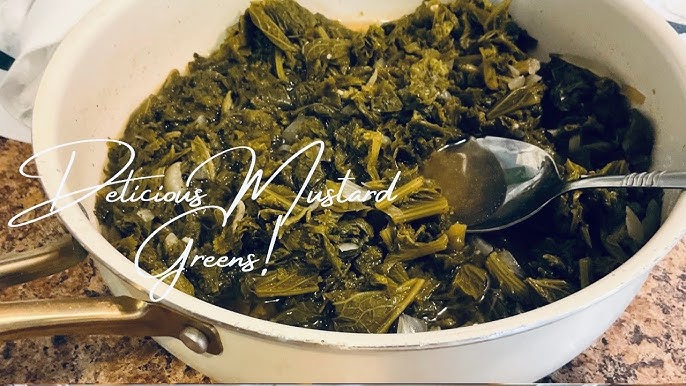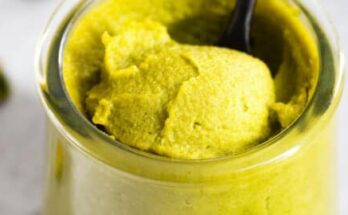Mustard Greens Recipe: If you’re looking to spice up your kitchen with a healthy, flavorful, and easy-to-cook side dish, look no further than mustard greens.
This leafy green veggie has long been a staple in Southern cooking and Asian cuisines, bringing a bold, peppery bite to your plate.
Whether you’re new to cooking greens or just looking for a better way to enjoy them, this step-by-step guide is here to help you master the perfect mustard greens recipe.
What are Mustard Greens?
Mustard greens are leafy vegetables from the same family as kale, cabbage, and broccoli—the mighty Brassicaceae. These greens have a unique flavor—sharp, peppery, and earthy—making them a standout among other leafy veggies. They come in different varieties, from frilly to smooth leaves, and range in color from bright green to deep purple.
These greens have been cultivated for centuries, especially in Asia and parts of Africa. In the U.S., they hold a prominent place in Southern soul food. What makes them special is not just their taste but their ability to absorb flavor, making them perfect for bold seasonings and spices.
Why You Should Eat Them
Besides being downright delicious, mustard greens pack a serious nutritional punch. They’re low in calories but high in fiber, vitamins A, C, and K, and essential minerals like calcium and potassium. They also contain antioxidants and compounds that support liver detox and heart health.
Eating mustard greens regularly can help improve digestion, reduce inflammation, and even boost immunity. Plus, their bold flavor can turn a boring plate into something extraordinary. If you’re aiming to eat healthier without giving up on flavor, these greens are the way to go.
Ingredients Needed
Fresh Ingredients
Here’s what you’ll need for a classic mustard greens recipe that’s big on taste and easy on the effort:
- 2 bunches of fresh mustard greens (washed and chopped)
- 1 medium yellow onion (sliced)
- 3 cloves garlic (minced)
- 1 tablespoon olive oil or bacon fat (for sautéing)
- 2 cups chicken broth or vegetable broth (for simmering)
- Salt (to taste)
- Black pepper (to taste)
- Red pepper flakes (optional for heat)
The star of the show is obviously the mustard greens, but don’t underestimate the supporting cast. Onion and garlic bring out the depth, while the broth softens the sharpness of the greens and helps marry the flavors together.
Optional Add-ins for Flavor
Want to kick things up a notch? Here are some bonus ingredients to jazz up your greens:
- Smoked turkey or ham hock (adds a rich, smoky flavor)
- Apple cider vinegar (for a touch of tang)
- Crumbled bacon (because, why not?)
- A dash of hot sauce (for spice lovers)
- A pinch of sugar (to balance bitterness)
These extras aren’t mandatory, but they sure do help tailor the recipe to your taste. Whether you’re aiming for smoky, spicy, or tangy, these add-ins allow you to personalize the dish without complicating it.
Preparing the Mustard Greens
Cleaning and Trimming
Cleaning mustard greens properly is a must. These leafy veggies can carry grit, dirt, or even tiny bugs in their folds, so don’t skip this step.
Here’s how to clean them the right way:
- Fill a large bowl or sink with cold water.
- Submerge the greens and swish them around vigorously.
- Let them sit for a few minutes so dirt settles at the bottom.
- Lift the greens out and repeat the process 2–3 times until the water runs clear.
Once clean, trim off the thick stems (especially the lower ones, which can be tough) and chop the leaves into bite-sized pieces. If you like your greens extra soft, consider blanching them for 1-2 minutes before cooking.
Tips for Reducing Bitterness
Mustard greens can sometimes be a little too bold—bordering on bitter. Here are a few tricks to tone that down without losing their natural bite:
- Cook them longer: Slow simmering helps mellow the flavor.
- Add acidity: A splash of vinegar or lemon juice balances bitterness.
- Throw in a pinch of sugar: Just enough to offset the sharpness.
- Use broth instead of water: It enriches the greens and softens their edge.
Follow these prep tips, and your mustard greens will be well on their way to perfection.
How to Cook Mustard Greens – Step by Step Guide
Step 1: Sauté Aromatics
Start by heating your oil or bacon fat in a large skillet or pot over medium heat. Add the sliced onions and let them cook until they turn translucent—about 5 minutes. Then toss in the minced garlic and cook for another minute until fragrant.
This base layer of flavor sets the stage for everything else. The caramelized onions add a slight sweetness, while garlic gives it that savory depth that makes greens irresistible.
Step 2: Add Mustard Greens
Next, pile in your chopped mustard greens. Don’t worry if it looks like too much—they’ll shrink down significantly as they cook. Stir them gently into the aromatics until they begin to wilt, about 3–4 minutes.
Once wilted, pour in your broth. This will help steam and tenderize the greens while infusing them with flavor. Add salt, pepper, and any optional seasonings like red pepper flakes or a dash of vinegar. Give it all a good stir.
Step 3: Simmer to Perfection
Now lower the heat, cover the pot, and let the greens simmer for 20–30 minutes. Stir occasionally and taste along the way. Adjust the seasoning as needed. If you like your greens extra tender, cook them a bit longer.
By the end of the cooking process, your mustard greens should be tender, savory, and deeply flavorful. Serve them hot, with their juices (called “pot liquor” in Southern cuisine), and enjoy the transformation from raw and spicy to rich and satisfying.
Serving Suggestions
Best Dishes to Pair With Mustard Greens
Now that you’ve mastered cooking mustard greens, let’s talk about what to serve them with. These greens are versatile and can elevate both humble and extravagant meals. Their bold, peppery flavor makes them a natural companion for rich, hearty dishes.
Here are some classic and creative pairings:
- Southern-Style Entrées: Think fried chicken, smothered pork chops, or BBQ ribs. The greens balance out the heaviness with their bitterness and acidity.
- Cornbread or Biscuits: Perfect for sopping up that flavorful “pot liquor” from the greens. Bonus points for jalapeño cornbread!
- Rice or Grits: A bed of creamy grits or fluffy white rice pairs beautifully with saucy greens, especially when topped with a bit of smoked meat.
- Beans and Legumes: Black-eyed peas, pinto beans, or lentils create a plant-based protein-packed meal with mustard greens.
- Eggs and Brunch Plates: Toss them into a frittata, omelet, or serve alongside sunny-side-up eggs for a bold brunch twist.
Don’t be afraid to mix and match. These greens are flavor powerhouses that can stand up to bold seasonings and rich textures. Whether you’re going Southern, vegetarian, or fusion, mustard greens will play along and make the meal memorable.
Storage and Reheating Tips
So you’ve got leftovers—lucky you! Mustard greens store surprisingly well and even taste better the next day as the flavors deepen and meld.
Here’s how to store and reheat them properly:
Storage:
- Let the greens cool completely before storing.
- Transfer to an airtight container.
- Store in the fridge for up to 4–5 days.
Freezing Tip: If you’ve made a large batch, freezing is a great option. Place the cooked greens (and some of the broth) in freezer-safe containers or bags. They’ll last up to 3 months. Thaw overnight in the fridge before reheating.
Reheating:
- On the stove: Add a splash of water or broth and reheat over medium heat until warm.
- In the microwave: Heat in a covered dish, stirring occasionally to ensure even warmth.
Whether you’re serving them fresh or from the fridge, mustard greens don’t lose their charm. Just reheat, maybe splash on a bit more vinegar or hot sauce, and enjoy all over again.
FAQs about Mustard Greens Recipe
1. What are mustard greens?
Mustard greens are leafy vegetables with a peppery flavor, belonging to the Brassica family. They are rich in vitamins and minerals, making them a nutritious addition to any meal.
2. How do you prepare mustard greens?
To prepare mustard greens, start by washing the leaves thoroughly to remove any dirt. You can then chop them and cook them by sautéing, boiling, or steaming. They pair well with ingredients like garlic, onions, and bacon for added flavor.
3. Can mustard greens be eaten raw?
Yes, mustard greens can be eaten raw and are often used in salads for their spicy kick. However, their slightly bitter taste is mellowed when cooked, which some people may prefer.
4. What are some common spices and herbs that go well with mustard greens?
Common spices and herbs that enhance mustard greens include garlic, onion, chili flakes, mustard seeds, and smoked paprika. For herbs, try pairing them with thyme or dill.
5. Are mustard greens suitable for a vegan diet?
Absolutely! Mustard greens are plant-based and make an excellent choice for vegan dishes. They can be cooked with other vegetables or used as a base for vegan soups and stews.
6. How long do mustard greens take to cook?
Mustard greens cook relatively quickly. They typically take about 5-10 minutes to sauté, while boiling or steaming might take a bit longer, depending on your desired texture.
7. Can you freeze mustard greens?
Yes, mustard greens can be frozen. Blanch them first for about two minutes, then plunge them into ice water, drain thoroughly, and freeze in airtight bags. This preserves their texture and flavor.
8. What are the health benefits of eating mustard greens?
Mustard greens are low in calories yet rich in fiber, vitamins C, A, and K, and antioxidants. They support heart health and may help reduce inflammation.
9. What’s a simple recipe to try with mustard greens?
A simple recipe to try is sautéed mustard greens with garlic and olive oil. Heat some olive oil in a pan, add minced garlic and cook until fragrant, then add the mustard greens and sauté until they’re wilted and tender. Season with salt and pepper to taste.
10. Are there any dietary concerns with mustard greens?
While mustard greens are generally safe for everyone, they do contain vitamin K, which can interact with certain blood-thinning medications. If you have concerns, it’s a good idea to consult with a healthcare provider.
Conclusion
Mustard greens are the unsung heroes of leafy vegetables—nutritious, flavorful, and incredibly versatile. With just a few simple ingredients and easy steps, you can transform these humble greens into a soul-warming dish that fits any meal. From prep to plate, they offer bold flavors, incredible health benefits, and endless pairing options.
Whether you’re a seasoned home cook or trying greens for the first time, this step-by-step mustard greens recipe will have you coming back for seconds (and thirds). Add your favorite twist, pair them with comforting sides, and enjoy the satisfying balance of health and flavor in every bite.



